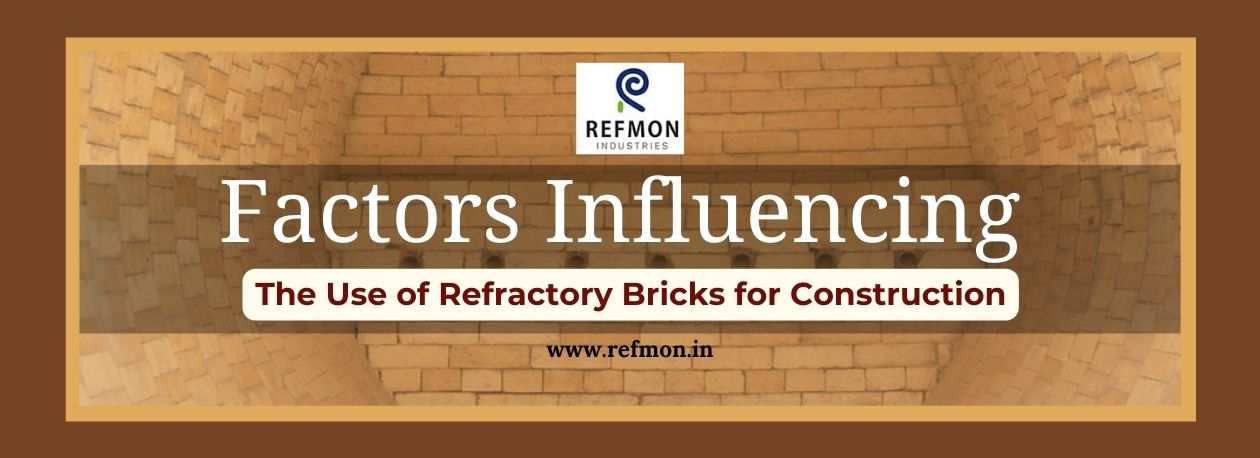
Factors Influencing: The Use of Refractory Bricks for Construction
Introduction
Heat, high temperature, pressure, or chemical attack can all cause putridity or damage to refractory materials. It can remain in this state for an extended period of time without changing. Many refractory materials, such as refractory bricks, fire bricks, refractory material, refractory cement, and so on, are available on the market and provide mechanical strength, chemical attack protection, even acid rain, heat, and pressure resistance by maintaining their structure.
Refmon Industries is one of the companies that produce this type of refractory material. The Refmon Industries produce refractory and insulation materials throughout India. Refmon Industries manufacture bricks, fire bricks, refractory bricks, high alumina bricks, burner blocks, and other refractory materials.
Name of Refractory Products
Bricks made of refractory materials: Refractory bricks are commonly used in the construction of kilns, furnaces, and other hot areas. Refractory bricks, also known as "Fire bricks," are a type of ceramic material. It is used in high-temperature environments due to its lack of inflammation.
Some characteristics of refractory bricks include:
● They can prevent cracks on the surface if there is any sudden temperature change
● They must absorb at most 6% water within 24 hours.
● They can preserve their firmness at high temperatures.
Refractory Cement
Refractory cement is typically a heat-resistant concrete that aids in preventing heat from causing mechanical damage. Refractory cement is used to bind materials in order to increase thermodynamic properties without reducing formability. Refractory cement is a mixture of fireclay and silica sand or fireclay and crushed brick.
Refractory cement is used in fireplaces and wood-burning stoves; it is also useful for patching furnaces and setting and bonding firebricks in firebox chambers. Also, using refractory cement to seal air and prevent gas leaks is extremely beneficial.
Acid Proof Bricks
Acid-proof bricks are another name for acid-proof bricks. Quartz, felspar, fire clay, and binders are used to make these bricks. Acid-proof bricks withstand acid attacks such as acid rain, alkalis, or any chemical attack on any wall or wall surface. This chemical attack has a high crushing strength and can cause damage. To protect against this type of crushing damage, acid proof bricks are extremely useful.
These bricks are used in masonry construction to protect any architecture or flooring apt to chemical attack.
Use Of Refractory Bricks For Construction
Because refractory bricks can withstand high temperatures, they are used as a building material to build the surface of walls and arches, particularly in areas where high temperatures are present.
Refractory bricks, also known as fire bricks, are used to build boilers, combustion chambers, chimney flues, and other structures.
Products Of the Refmon Industries
Refmon Industries provide those refractory products which are made from high-quality raw materials. It assures high heat resistance and long life to function.
Refmon Industries make high-quality fire bricks or refractory bricks, which are also custom-made to fulfill the consumer's purposes. Their refractory products are available all over the country. Refmon Industries products are best in class, so customers can use them for industrial purposes. Aside they make their refractory product's materials for all types of purposes.
Refmon Industries also manufactures acid-proof bricks, which are used for flooring of masonry construction, towers in chemical plants, etc., to resist the damage of the surface by acid or other chemicals.
Conclusion
In product manufacturing, refractory material plays an important role. Like refractory bricks are used for construction, every product is helpful for its features. But the essential common fact is all refractory material has the same intention to prevent the high temperature and mechanical pressure from producing products without any damage.